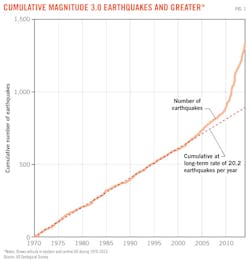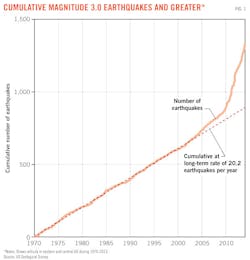Link strengthened between wastewater injection and Oklahoma earthquakes
LINCOLN COUNTY, Okla. — New research suggests that a magnitude 5.7 earthquake that struck near Prague, Okla., in 2011 and led to hundreds of smaller aftershocks was triggered by a smaller quake, or foreshock, linked to wastewater injection wells near a known fault.
"The observation that a human-induced earthquake can trigger a cascade of earthquakes, including a larger one, has important implications for reducing the seismic risk from wastewater injection," said Elizabeth Cochran, US Geological Survey (USGS) seismologist and coauthor of the study: Observations of static Coulomb stress triggering of the November 2011 M5.7 Oklahoma earthquake sequence, published in April in the Journal of Geophysical Research.
The earthquake, which occurred on Nov. 6, 2011, was the most powerful ever recorded in Oklahoma. It destroyed 14 homes and was felt as far away as Milwaukee, Wis. Prior to the event, Oklahoma had not seen an earthquake of magnitude 5 or greater on the Richter scale since 1952.
Less than 24 hrs before the magnitude 5.7 earthquake occurred, a magnitude 5.0 foreshock struck near active wastewater disposal wells. The new research suggests that this foreshock may have triggered the main shock by increasing stresses where the main shock occurred. The magnitude 5.7 quake ruptured a part of the Wilzetta fault system, leading to hundreds of smaller aftershocks that Danielle Sumy, coauthor of the study and a researcher with the Seismicity Consortium at the University of Southern California, said continue to be felt in Oklahoma.
The largest of the aftershocks was a magnitude 5.0 earthquake on Nov. 8, 2011. Sumy said seismic activity is presently most pronounced in the town of Jones, Okla., just northeast of Oklahoma City and about 35 miles southwest of Lincoln County, Okla., the epicenter of both major quakes.
An earlier study linked the foreshock to active fluid injection into wastewater disposal wells near the Wilzetta fault. Wastewater had been pumped into the abandoned oil wells for nearly 18 preceding years without incident, making the occurrence unusual.
Researchers figure that as wastewater refilled compartments once filled with oil, the pressure needed to keep the fluid going down had to be increased. As that pressure built, it caused the fault to slip. "A buildup of pore pressure after [about] 18 years of fluid injection likely triggered the [magnitude] 5 foreshock," the earlier study found.
Sumy told UOGR, "To try to drive a lot more water down into the wells they had to increase the pressure along that region. What likely occurred is, over that 18 year time span, there was an increase in pore pressure along the fault, and we know an increase in pore pressure will likely drive a fault toward failure."
More research is needed on the subject, Sumy said, and efforts could be aided by providing researchers with access to more comprehensive data sets.
Oklahoma presently requires wastewater well operators to tabulate the volume and rate of water injection on a monthly basis and report that data to the state annually. But, Sumy said, it would be easier to identify a link between changes at a particular injection well and seismic activity if daily, and even hourly, injection rate information were available.
"It's really hard to correlate any sort of earthquake that happens almost instantly to any sort of wastewater injection when we only have monthly data. We only know what they have done on a monthly basis versus what they're doing on a daily, even hourly basis," Sumy said.
The Oklahoma Corporation Commission, which oversees the collection of injection data, has taken note of this need and recently approved new rules that would require injection well operators to collect daily information on injection volume and pressure. Operators would be required to provide the data if the commission requests it. The rules must now be approved by the state legislature and signed by the governor.
Seismic activity
Earthquakes in the central US are uncommon; however, a number of moderate-size earthquakes occurred in 2011 in Colorado, Texas, Oklahoma, Ohio, and Arkansas. Many of these earthquakes, USGS said, occurred near wastewater injection wells, and some were found to be caused by human activities.
More broadly, the number of earthquakes recorded in the central and eastern US has increased in recent years. More than 300 earthquakes above a magnitude 3.0 occurred during 2010-12, USGS data show, compared to an average rate of 21 events/year during 1967-2000. The agency said earthquakes above a magnitude 3.0 are "fairly small—large enough to have been felt by many people but small enough to rarely have caused damage."
USGS noted that hydraulic fracturing does not appear to be linked to the increased rate of magnitude 3 and greater earthquakes. Sumy also said her research found no direct link between the Oklahoma quakes and hydraulic fracturing.
However, the amount of wastewater generated by hydraulic fracturing in the US has increased in step with unconventional oil and gas production.
Oklahoma is the fifth-largest oil producing state in the US, and oil and gas production has risen in recent years in line with rising development of unconventional formations such as the Woodford shale, the Granite Wash, and the Mississippi Lime. As production increases so, in turn, does the amount of flowback and wastewater generated.
Sumy said Oklahoma seismic activity first increased 2009, correlating with an increase in oil and gas production.
Researching causes
Of the more than 4,000 wastewater injection wells in Oklahoma only two or three have been linked to the earthquakes.
"When you think about the magnitude of how many injection wells there are and how many actually induce earthquakes it's very few," Sumy said. "There's got to be this very objective balance. We need oil and gas to power our homes, our cars and what-have-you, and we also need to be able to do this safely so it doesn't trigger earthquake activity or other things," Sumy said.
USGS is working with the US Environmental Protection Agency, the Department of Energy, and other federal agencies to gain a better understanding of induced seismicity in the US. Research focuses on injection-induced earthquakes and wastewater disposal technologies. The agency has worked with university partners to position seismometers to gauge the level of seismic activity in areas of known or possible injection-induced earthquakes in Arkansas, Colorado, Ohio, Oklahoma, and Texas.

